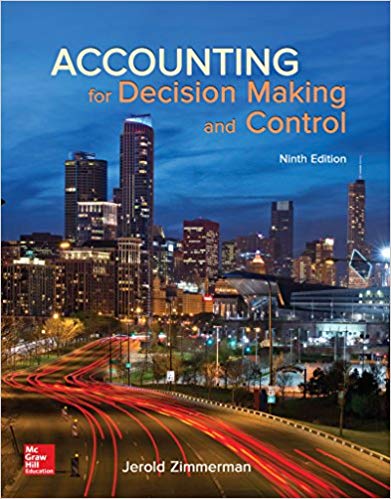Ranjha Inc. manufactures widgets. The end product is produced in different departments within the plant. One component, C1, is causing some concern. The component is
Ranjha Inc. manufactures widgets. The end product is produced in different departments within the plant. One component, C1, is causing some concern. The component is integral to the production of widgets, but is readily available in the marketplace. The machine used to produce the component is nearing the end of its useful life and management is trying to decide whether to replace it or outsource the supply. The current manufacturing costs of the C1 are as follows:
Direct materials $20.25 per unit
Direct Labour $16.00 per unit
Variable manufacturing overhead $8.00 per unit
Variable general Administration $7.00 per unit
Other costs related to C1 Department:
Supervision $240,000 per year
Amortization $360,000 per year
General Administration $400,000 per year
The plant can produce 100,000 units per year. It needs 65,000 units of C1 for widget production and sells 20,000 units externally at a price of $71.00. It incurs variable selling costs of $4.00 per unit when it sells C1 externally. Their policy is to fulfil internal requirements first, then sell C1 externally. Pluto Corporation has approached Santana with a proposal to produce C1 for them. The cost would be $69.00 per unit. Pluto guarantees on-time delivery and has agreed to a penalty of 25% of revenue on any late shipments. Pluto has further agreed to provide up to 90,000 units per year and has guaranteed the price of $69.00 for the entire five year contract. Santana can purchase a new machine to replace the existing equipment used to produce C1 for $4,600,000. It is anticipated the new machine will result in labour cost savings of 10%. All other costs will remain the same. The new machine's useful life is expected to be 5 years and its residual value at that time will be $150,000. It will be classified as a class 8 asset for tax purposes, with a CCA of 20%. The capacity of this new machine will be 100,000 units per year. The corporate tax rate is 40% and the company requires a 10% return, after tax, on this investment. 2 Management of Santana asked its marketing research group to determine the anticipated demand for widgets over the next 5 years. Management also asked the group to determine whether the excess capacity could be used to produce C1 for external sales. The marketing group reported the following information: 1. Demand for widgets will be approximately 65,000 per year for the next three years, and will increase to 70,000 in years 4 and 5. 2. The company expects external sales will be 18,000 units per year for the first three years and will increase to 25,000 units per year for the last two years. Management estimates that 40% of the supervisory costs and $100,000 of general administration expenses would be eliminated if the C1 were outsourced. Management also feels that there will need to be modifications to the design of the C1 in future years in order for the widget to remain competitive. The machine's manufacturer has assured Santana management that the changes will be possible at virtually no change in cost. Pluto Corporation has indicated that any design changes would incur additional costs for Santana.
Required: Assume that you have been hired by Santana Inc. to determine whether the company should buy the new machine or outsource production of C1. preper a quantitative analysis, and evaluate any qualitative factors that will be relevant to the decision. Provide a recommendation for management.
Step by Step Solution
There are 3 Steps involved in it
Step: 1
To determine whether Santana Inc should buy a new machine or outsource production of component C1 well perform a quantitative analysis comparing the costs of both options over a fiveyear period additi...
See step-by-step solutions with expert insights and AI powered tools for academic success
Step: 2

Step: 3

Ace Your Homework with AI
Get the answers you need in no time with our AI-driven, step-by-step assistance
Get Started


